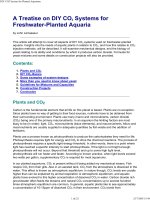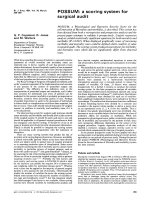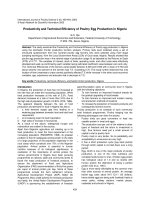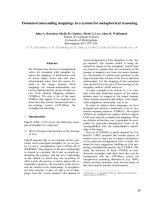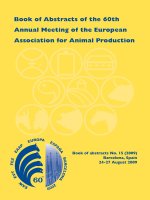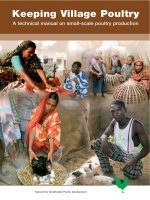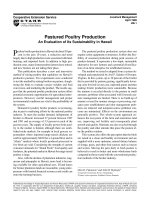Small-Scale Pastured Poultry Grazing System for Egg Production doc
Bạn đang xem bản rút gọn của tài liệu. Xem và tải ngay bản đầy đủ của tài liệu tại đây (715.08 KB, 11 trang )
Livestock Management
July 2009
LM-20
Small-Scale Pastured Poultry Grazing System
for Egg Production
Glen K. Fukumoto
Department of Human Nutrition, Food and Animal Sciences
R
aising you own food can be fun, rewarding, and
also a great educational tool to teach children about
simple animal husbandry responsibilities and the food
production chain. There is a strong need in today’s so-
ciety to build upon the connections between the farms
and ranches involved in agricultural production as the
main sources of our food. With a greater interest in
supporting local food production systems and commu-
nity discussions about becoming more food self-reliant,
small-scale poultry grazing systems can be integrated
into many small farmsteads in our tropical ecosystems.
With the closure of many commercial poultry operations
in Hawai‘i and in other Pacic island nations, small farms
will play an important role in improving community food
security and sustainability and will be a vital link toward
building a network of people involved in the production
and marketing of high-quality artisanal foods.
The objectives of this publication
are to discuss the overall benets of
pastured poultry grazing, to provide
basic guidance for developing a
small-scale system, and to help you
dene your expectations about such
a system.
Benets
The pastured poultry grazing system
is not a new production model but
rather is one that incorporates many
natural systems in a holistic approach
to benet the ecological, social, and
economic goals of individual opera-
tors. The possible benets of starting your own pastured
poultry unit include
•
providing fresh meat and/or egg products with a mini-
mal carbon footprint or the need to import food miles
•
recycling of household food residuals reduces our
waste stream to the landll and our environment
•
developing an agricultural “ethic” in our children, by
providing an understanding of where food comes from
•
developing livestock husbandry skills and builds re-
sponsibilities in caring for animals that produce food
•
introducing and integration of the natural systems
(mineral, water, and plant growth cycles) involved in
agriculture
•
providing a sense of pride when providing high-quality
foods in the community
•
providing a potential source of additional revenue for
the farmstead
•
requiring less money than other
larger systems and a relatively
small production area
•
providing a fun relaxation activ-
ity for families and a rewarding
system to operate
•
producing functional foods with
highly nutritious compounds
unique to forage-based production.
Limitations
Although there are numerous ben-
ets with these production systems,
there are also some limitations,
including the following:
Fresh pasture-produced egg (left)
compared to a typical imported egg.
Published by the College of Tropical Agriculture and Human Resources (CTAHR) and issued in furtherance of Cooperative Extension work, Acts of May 8 and June 30, 1914, in coopera-
tion with the U.S. Department of Agriculture. Andrew G. Hashimoto, Director/Dean, Cooperative Extension Service/CTAHR, University of Hawai‘i at Mānoa, Honolulu, Hawai‘i 96822.
An equal opportunity/afrmative action institution providing programs and services to the people of Hawai‘i without regard to race, sex, age, religion, color, national origin, ancestry, dis-
ability, marital status, arrest and court record, sexual orientation, or status as a covered veteran. CTAHR publications can be found on the Web site <
UH–CTAHR Small-Scale Pastured Poultry System for Egg Production LM-20 — July 2009
•
Grazing environment and forage availability: The
area should have adequate rainfall to sustain forage
growth through most of the year. Variation in rainfall,
elevation, and soil quality will affect the suitability of
the system.
•
Landscape terrain: The pen is limited to relatively
at areas and should not be used on steep, uneven, or
rough terrain. Improper site selection will make live-
stock access and movement of the cage more difcult.
Uneven terrain may allow predators to enter under the
pen and prey on the hens.
•
Livestock management: Livestock systems require
frequent care and attention. You will need to allocate
time for animal husbandry activities, such as feeding,
checking the water supply, harvesting eggs, moving
the cage, and others tasks.
•
Local zoning varies by counties: Check local zoning
regulations and/or subdivision covenants, conditions,
and restrictions to see if livestock is allowed in your
area.
Rotational grazing management
Oftentimes the controlled grazing aspects of the pastured
poultry units are overlooked. Controlled grazing, also
known as rotational grazing, intensive grazing manage-
ment, or managed intensive grazing, adds many benets
to the landscape and operation, including the following:
•
Animals are exposed to fresh, green forage regularly.
•
Replacing imported feeds with supplemental, high-
quality forages reduces operational feed costs.
•
Forage cover crop reduces bare ground exposure and
soil erosion and encourages water percolation and
water holding capacity of the soil.
•
Rotational grazing increases the plant’s rest and re-
covery period, stimulating plant vigor and growth.
•
A well developed forage plant community reduces
weed competition.
•
Distribution of manure is done by the birds and
through the rotational system.
•
No manure buildup results in signicant odor and
vector reduction.
•
Nutrients from the manure (organic and mineral
compounds) stimulate the nutrient cycling processes
through the soil, building soil microbial activity, fer-
tility and quality, thus beneting plant growth in the
grazing area.
•
Solar disinfection by ultraviolet radiation reduces hu-
man exposure to pathogens contained in the manure.
•
A chicken’s innate behavior to scratch encourages soil
surface aeration and organic matter incorporation into
the soil.
•
Animals become docile through daily exposure to
humans.
Pasture poultry grazing pen designs
There are many examples of pasture-based poultry pro-
duction systems and designs. Key driving forces behind
the expanding knowledge base of this production model
are led by farmer and author Joel Salatin of Virginia
() and the American Pas-
tured Poultry Producers Association (pa.
org), based in Pennsylvania.
The unit design and data on the forage crop used, egg
production, and economics are specic to this case study.
The discussion in this publication is intended to help you
in the basic understanding of the system and be a guiding
document for your pastured poultry project. Therefore,
this publication will not cover specics in raising the
birds from chicks to the initial laying production stage.
The case study site was located at 1500 feet elevation in
a 35-inch annual rainfall belt where temperatures range
from a low of 53° to 90°F in mid-summer.
Case study in egg production
The pastured poultry grazing unit, also referred to as a
“chicken tractor” or “grazing cage,” is a an open-bottom
mobile pen that includes a water system, feeding trough,
roosting rod, nesting box with egg collection system,
and shelter for poultry. The open-bottomed pen provides
access to grazing by the mature hens while providing
protection from predators (dogs, mongoose, hawks). In
this system the birds are not allowed to roam freely on the
farmstead property but are managed under your control
in the grazing system. Control of the animals prevents
unwanted damage to your vegetable or ower garden
beds and soiling of household living areas.
Design preferences
Scan the Internet and you will see a multitude of design
options. The basic design used in this case study was
based on pastured broiler grazing cages observed at a
Sustainable Agriculture Research and Education con-
ference visit to a Texas farm. The pen in this study was
modied with a nesting box and an egg collection system
and reduced in dimension and scale.
2
3
UH–CTAHR Small-Scale Pastured Poultry System for Egg Production LM-20 — July 2009
Figure 1. Diagram of grazing cage identifying the various components.
Materials and supplies
An exact parts size list is not given for the grazing cage
construction; however, by reviewing the parts list (see
Appendix 1) and using the diagram in Figure 1 as a guide,
the unit is relatively easy to build by a do-it-yourself
enthusiast.
The weight of the cage will vary with the type of
construction materials used. A PVC cage is relatively
light compared to lumber. The use of lighter gauge wire
netting and aluminum or plastic roong material will
help to reduce the overall weight of the pen. The heaviest
single component of the system is the water contained
in the 5-gallon bucket. The easiest time to move the pen
is when the water system is empty. Observe and match
your cage rotation with the water consumption patterns.
For example, if the cage rotation is every 3 days, ll only
enough water in the system for a 3-day consumption
period. This may keep you from straining your back or
getting hurt while moving the unit. Another option to
facilitate pen movement is to strategically add wheels
to the unit, or keep a piece of pipe nearby to roll it on.
Breeds and egg color
Individual operators have their own preferences, such
as for a particular color or certain type of food. Similar
preferences apply with poultry breed choices, so breeds
will not be discussed here. Another consideration, in
relation to breed type, is the natural color of eggs, which
usually range from white to brown, can be light blue or
green, and may have solid color or be speckled.
Density
The area of the pen oor space may vary, but some
recommendations are provided here. In this case study,
four hens were housed in the grazing cage, providing an
area of 8.75 ft
2
per bird. Optimum space requirements
UH–CTAHR Small-Scale Pastured Poultry System for Egg Production LM-20 — July 2009
Table 1. Relationship between stock density and rotation
frequency for a 35-ft
2
cage.
Total daily Rotation
Number Space per forage frequency
of hens hen (ft
2
) consumption* (oz) (days)
2 17.5 0.76 6
4 8.8 1.52 3
6 5.8 2.28 2
8 4.4 3.04 1.5
10 3.5 3.80 1.2
*Forage yield estimates and per-hen grazing estimates of the
perennial peanut for a 5 x 7-ft grazing cage are 4.6 ounces and 0.38
ounce per day, respectively.
specied by M.E. Ensminger (1971) for battery cage layer
systems range from 2.5 to 3.5 square feet per bird for
general-purpose breeds. Higher bird density will result
in greater feed and forage demands, thus increasing the
rotation frequency of the grazing cage unit. See Table
1 for examples.
Providing feeds and forages
A commercial layer feed was used as the main portion
of the diet. The forage component in the pastured poul-
try grazing system provides a supplemental source of
nutrients but will not provide all of the energy, protein,
and mineral requirements for optimum egg production.
As an omnivore, a chicken does not have the ability to
utilize structural carbohydrates for energy, as do rumi-
nant animals (cattle, sheep goats, etc.).
Feed requirements will vary with the size of the laying
hens, with smaller breeds ranging in bodyweight from 3
to 4.5 pounds and requiring 66–110 grams (2–4 ounces)
of dry matter intake per day for optimum production.
Larger breeds may reach mature bodyweights in excess
of 7 pounds and require feeding levels of 155–165 grams
(5.5–6 ounces) per day. Do not feed more than the rec-
ommended level, as you will not get more production
out of the hens. Offer just enough feed so that the hens
consume all feed offered within 30 minutes.
Additionally, fresh food scraps provide a good diver-
sity in the hens’ diet. The omnivorous chicken can basi-
cally consume the same foods as we do. If the hens are
fed to a point of satiety, grazing behavior will be reduced.
Figure 2. Pastured poultry grazing cage in action. Photo
shows recovery of perennial peanut groundcover at 0, 5,
and 12-days post-grazing.
You will need to ne-tune and balance grazing behavior
and consumption of the feed ration. One strategy is to
move the cage prior to feeding, so that the hens will seek
out the diversity in the next offering of forages, such as
weeds, owers, or insects, in the new grazing area before
consuming the commercial grain mix.
Forage choices
There are many types of forage that you can select for
the system; the best advice is to start with utilizing the
forages that are established in your grazing landscape
and continue to experiment with other forages with a
goal of increasing forage biodiversity over time. Most
any stoloniferous-type forage grasses and legumes will
be grazed by chickens and will enhance grazing cage
moves in the pasture rotation. Avoid incorporation of
bunch-type grasses, such as guinea grass (Panicum maxi-
4
5
UH–CTAHR Small-Scale Pastured Poultry System for Egg Production LM-20 — July 2009
mum) and/or shrub-type forage legumes (pigeon peas,
Cajanus cajan) into the grazing area as, these plants will
make it difcult to move the pen. One of the challenges of
tropical pastoral ecosystems is to establish and maintain
high-protein or nitrogen-rich sources of forage within
the plant community. Protein-rich feed ingredients are
one of the costliest components of a complete livestock
feed ration. Thus, in this case study, the legume called
perennial peanut, Arachis pintoi, was used as the base
forage. The perennial peanut is favored due to its innate
ability to x nitrogen from the atmosphere, adaptability
to a wide range of environmental conditions, persistence
due to a strong root system, seeding ability, and non-
twining growth characteristic.
Forage production and composition
The chemical analyses from two samples taken of the pe-
rennial peanut are presented in Appendix 2. The grazed
clip sample estimates the birds’ consumption based on
a visual appraisal of a three-day grazing residual, i.e.,
the forage sward was clipped to mimic the actual grazed
residual. The total biomass clip sample represents the
entire column of forage taken from the top of the for-
age canopy down to soil level, approximately 9 inches
deep. The strata of the harvested column consisted of
approximately 25% leafy material and 75% stems. The
grazed clip analysis was used in the available nutrient
calculations.
Nutrients provided by forage
In the case study, the hens were fed a commercial layer
mixed ration daily, approximately one cup per day. This
amount averaged 2.5 ounces or 70.9 grams/hen/day. The
5x7-foot grazing cage dimension provided 1.2 pounds of
fresh forage for the four laying hens over a period of three
days. The perennial peanut forage provided the following
portions of the hens’ daily nutrient requirements: crude
protein 52.5%, calcium 24.5%, phosphorus 25.7%, and
the amino acids lysine 60.9%, and methionine 37.1%.
See Table 2 for nutrient contributions.
Grazier’s notes
Reduced forage production
During times of slow forage growth, due to drought or
seasonal effects, the pen rotation should be slowed down,
allowing more time for the plants to recover. However,
the immediate grazed area will result in heavy animal
impact (grazing and scratching) and bare ground expo-
sure. During this period you will need to add a bed of
carbon materials on the oor of the pen, such as leaves,
grass clippings, or mulch, to cover the bare ground and
prevent unwanted weed establishment. This technique of
dry litter bedding will allow extended rest periods for
the other grazed sections.
Figure 4. Daily crude protein requirement per hen (left)
and amount of crude protein provided from grain and
forage.
Crude protein (g)
Figure 3. Range of daily dry matter required by a mature
laying hen (left) and amount of dry matter provide from
grain and forage.
Dry matter (g)
UH–CTAHR Small-Scale Pastured Poultry System for Egg Production LM-20 — July 2009
Figure 5. (Left) Actual grazing residual prior to rotation of the grazing cage. (Right) Using calibrated vegetative hoops
(Synergy Resource Solutions, Bozeman, Mont.), an estimate of forage removal by the hens can be calculated.
Table 2. Daily nutrient requirements of laying hens and nutrients provided by commercial feed and forage components
of the diet.
Minimum daily Available daily Available daily Total available Daily nutrients
requirements* nutrients from nutrients from daily nutrients available from
Nutrients per laying hen (g) grain, per hen (g) forage, per hen (g) per hen (g) forage (%)
Dry matter 66–110 67 45 112 41–68
Crude protein 16 14.2 8.4 22.6 52.5
Calcium 3.8 5.0 0.9 5.9 24.5
Phosphorus 0.35 0.6 0.09 0.69 25.7
Lysine 0.7 0.6 0.43 1.03 60.9
Methionine 0.35 0.28 0.13 0.41 37.1
*National Research Council Subcommittee on Poultry Nutrition, 1984
Weed control
If you have a particularly weedy area, the concentration
of hens over an extended period of time will help to
reduce the weed stand by grazing and scratching. The
hens can remove the forage sward to bare ground. If this
happens, it would be a good time to plant a desired forage
species (during the growing periods).
Other feedstuffs
Pigeon pea (Cajanus cajan) is a tropical/subtropical
legume that can be grown separately in a feed bank
system where the harvested pea can be left on the stem
and fed intact to the hens. The hens will shell the pods
and eat the peas.
Papaya (Carica papaya) fruit is an excellent supple-
mental feed source.
Grain sorghum (Sorghum spp.) volunteer seedlings
became established in the grazing area and were readily
grazed by the hens.
Ti (Cordyline terminalis) leaves can also be fed as
a supplement. Hens will pick on the leaves and bark of
harvested mature and seedling ti plants.
Other leafy perennials, such as edible hibiscus (Abel-
moschus manihot) and tropical asparagus (Sauropis
androgynus), provide diversity to the hens’ diet.
Household food residuals can also be fed. Items such
as bread, rice, vegetables, fruits, and some meats were
fed.
6
7
UH–CTAHR Small-Scale Pastured Poultry System for Egg Production LM-20 — July 2009
Figure 6. The partial nutrient cycling that occurs in the grazing system.
Nutrient cycling potential
During an annual cycle, one mature laying hen will
produce approximately 88.3 pounds and 1.36 cubic feet
of manure (25% dry matter). Removing the moisture
from the manure results in 22.1 pounds of dry matter,
1.21 pounds of nitrogen, 0.45 pounds of phosphorus,
and 0.50 pounds of potassium. The organic carbon to
nitrogen ratio of the layer manure is 7. Thus in this case
study, four hens would produce approximately 88 pounds
of dry manure and 5, 2, and 2 pounds of nitrogen, phos-
phorus, and potassium per year, respectively. The small
contribution of nutrients and organic matter will start to
stimulate the nutrient cycling in the rotational grazing
area. As production continues over time, the nutrient
cycling will continue to build and improve the soil and
forages in the area.
Manure management
There is no manure management problem with the
system. The hens do the distribution of manure, thus no
buildup occurs. Odors and vector concerns are virtually
eliminated.
Egg production and economics
It is well documented that as the hen ages, her egg pro-
duction will drop. In commercial egg farms, most laying
hen’s productive lifespan is approximately two years.
Figure 7 shows the egg production of the hens over the
span of the data collection period.
Pastured poultry egg production will probably not
match the productivity of environmentally controlled
commercial operations; however, with pasture supple-
mentation, the direct costs of feed per dozen eggs may
be competitive with commercial production guidelines
in the rst year of production. Table 3 describes the
commercial ock production goals (Ensminger 1971)
and results of productivity and cost per dozen eggs. Key
values include the amount of feed required to produce
a dozen eggs and conversion factors. Keep in mind that
in this case study, a full economic cost-of-production
analysis was not conducted; it would include the cost of
the chicks, pullet development, cage materials, pasture
development, labor, and other costs. Due to the decline
in production by Year 3, layers should be replaced in
two- or three-year cycles.
UH–CTAHR Small-Scale Pastured Poultry System for Egg Production LM-20 — July 2009
Figure 7. Monthly egg production over a 2.5-year production run, started in October.
Estimating your cost per dozen eggs
The data generated from this demonstration can be used
to estimate feed cost per dozen eggs produced. Manufac-
tured feed prices have dramatically increased in recent
times, nearly 40% over the span of the data collection
period. This section will give you an idea of what you can
expect from your homestead pastured poultry production
in determining feed cost per dozen eggs produced rela-
tive to the price of eggs in the marketplace. Use values
derived from Table 3.
Method 1: Multiply the feed/dozen value by the cost per
pound of feed to calculate the cost per dozen.
Method 2: Multiply the cost/bag of feed by the conversion
factor to calculate the cost per dozen.
The cost per dozen produced will increase with the age of
the hens; use the appropriate value for the age of the hens.
Example: Assumption: Cost for a 50-lb bag of feed is
$20.00 ($0.40 per pound).
For Method 1, multiply 0.40 x 3.36 = $1.34/dozen
For Method 2, multiply 20 x 0.06696 = $1.34/dozen
Other considerations
Animal health
No serious animal health issues and concerns were
observed during the case study. However, be vigilant in
your observation of the hens, as issues may arise.
Pecking order
Sometimes, when establishing the pecking order of the
clutch, several hens may single out and pick on another
hen. Minor beak trimming, to remove the sharp points,
may help to reduce injury to the hen. If picking continues,
it may be due to other causes. Most common reason is
8
9
UH–CTAHR Small-Scale Pastured Poultry System for Egg Production LM-20 — July 2009
Table 3. Data on production and costs.
Commercial
production goals* Year 1 Year 2 Year 3
Average eggs/hen/day 0.66 0.56 0.36 0.19
Average eggs/hen/year 240 204 131 69
Large eggs or better 75% NA NA NA
Feed/dozen, lb 4.5 3.36 5.22 9.92
Conversion factor - 0.06696 0.10417 0.19737
Feed cost/dozen
1
0.99 1.54 2.91
*From Ensminger 1971; NA = No egg sizing was done;
1
Based on $14.50 per 50-pound bag
related to mineral nutrition; where oftentimes a simple
topdressing of table salt (1–2 teaspoons) over the feed
for a couple of days will solve the problem.
Bathing box
A dusting box lled with soil, sand, or ground basalt
may be added to the pen. The hens will use it to bathe
themselves.
Parasites
In poultry grazing systems, the birds’ exposure to dis-
eases and parasites is higher, so you need to be vigilant
in daily observation of the health of the hens.
Environmental effects
In cooler and higher rainfall environments, a plastic tarp
secured around half of the pen will help to protect the
hens from the cold, wet weather.
Conclusion
A pastured poultry grazing system for egg production
is a simple and low-cost way to incorporate livestock
into your farmstead operation to produce a high-quality
protein food source and improve your family’s and your
community’s food self-reliance. As you start to produce
your own food, you become attuned to and cognizant of
the sources of food that are grown by the farmers and
ranchers in our communities.
Acknowledgments
Mahalo to fellow colleagues and poultry grazers Mat-
thew Stevenson and Luisa Castro for their technical
review and suggestions for the manuscript, and to Dr.
Mark Thorne for help with the forage analysis.
References
American Pastured Poultry Producers Association, Boyd,
Wisc. www.apppa.org.
Backyard chickens. www.backyardchickens.com/coop-
designs.html.
Clancy, Kate. 2006. Greener pastures—How grass-fed
beef and milk contribute to healthy eating. Union of
Concerned Scientist, Cambridge, Mass. www.ucsusa.
org.
Ensminger, M.E. 1971. Poultry science, 1st ed. The
Interstate Printers and Publishers, Inc., Danville, IL.
Hensley, David, Julie Yogi, and Joseph DeFrank. 1997.
Perennial peanut groundcover. CTAHR, University of
Hawaii at Manoa, OF-23. www.ctahr.hawaii.edu/oc/
freepubs/pdf/OF-23.pdf.
National Research Council Subcommittee on Poultry
Nutrition. 1984. Nutrient Requirements of Poultry,
8th Revised ed., National Academy Press, Washing-
ton, D.C.
Robinson, Jo. 2004. Pasture perfect: The far-reaching
benets of choosing meat, eggs and dairy products
from grass-fed animals. Vashon Island Press, Vashon,
UH–CTAHR Small-Scale Pastured Poultry System for Egg Production LM-20 — July 2009
Wash.
Salatin, Joel. Polyface Inc. Swoope, VA. www.polyface-
farms.com.
Synergy Resource Solutions, Inc. Bozeman, MT. www.
countgrass.com.
U.S. Department of Agriculture, Natural Resources Con-
servation Service. 1996. Chapter 4, Agricultural waste
characteristics, Agricultural Waste Management Field
Handbook, Part 651, National Engineering Handbook.
Appendix 1. Materials list for pastured poultry
grazing cage (dimension: 5 ft wide by 7 ft long)
1-inch PVC parts for cage
10 elbows
32 tees
2 crosses
120 ft PVC pipe
1
⁄
2
-inch PVC parts for cage cover
4 elbows
12 ft PVC pipe
Other materials
PVC primer
PVC glue (dry-t parts before permanently gluing all
connections)
1 box each of 1-inch self-tapping screws and lock washers
35 ft “chicken netting” hardware wire, 3 ft wide
PVC “clips” (made from 1
1
⁄
2
-inch PVC pipe segments,
cut laterally into thirds)
Water system
5-gallon bucket
Rubber washer
Flexible hose
2 barbed couplers,
1
⁄
2
MPT x
1
⁄
2
barbed end
1
⁄
2
-inch FTP cap, cut off cap end, use to secure barbed
coupler to bucket
Gate value
Coupler,
1
⁄
2
S x
1
⁄
2
FPT
Automatic water bowl or nipple (www.farmtek.com,
www.enasco.com)
Other commercial water systems: Ziggity Systems, Inc.,
Lubing Systems, L.P.
Feeder
5-ft vinyl rain gutter; set feeder at a slight angle to allow
directional drainage of rainwater; drill a few holes in
the bottom to allow water drainage.
2 gutter end caps (purchase or cut two pieces of wood to
match the prole of the gutter)
Roof
10-ft corrugated roong panel (aluminum or berglass
panel preferred due to material weight)
Nesting box
1 cubic foot cube with wire mesh oor, interior painted
black.
Option: purchase a plastic container and adapt it as a
nesting box.
Pull handles
String a short piece of
1
⁄
2
-inch PVC pipe through sev-
eral strands of soft, heavy-gauge wire to form a pair
of handles. Place the pair of handles on each side of
the pen.
Construction notes and hints
Hardware wire. Base the height of the cage sidewalls
(not including roof line) on standard hardware wire
width. Three feet height is adequate for hens. The
cage is not meant for the operator to crawl in and out
on a daily basis.
PVC clips. Cut “clips” from 1-inch diameter PVC pipes.
Cut a 1
1
⁄
2
-inch section of pipe, then cut it laterally to
make three clips.
Roof material. Aluminum or berglass panel is preferred
due to its light weight; however, it may cost more than
standard galvanized panels.
Feed trough. Use plastic rain gutter as feed trough. Set
the trough at a slight angle to allow directional drain-
age of rainwater. Also, drill a couple of holes in the
bottom to allow water drainage.
Before nal gluing. Dry-t all parts before permanently
gluing the connecting sections and joints.
Final note. Keep in mind that the grazing cage is bot-
tomless to allow forage grazing.
10
11
UH–CTAHR Small-Scale Pastured Poultry System for Egg Production LM-20 — July 2009
Basic framework of the grazing cage.
Detail showing construction of reinforced corner design
with water container support.
A simple plywood and wire nesting box allows easy
retrieval of eggs. Only one nesting box is required, as
the hens will share it.
Appendix 2. Chemical composition of perennial
peanut, grazed and total biomass analyses.
Total
Graze biomass
clip clip
(n = 3) (n = 1)
Yield, dry matter basis, lb/ac 1,493 11,840
Dry matter as harvested, % 23.83 37.95
Crude protein, % 18.5 13.2
Neutral detergent ber, % 32.0 30.3
Acid detergent ber, % 25.9 24.9
Lignin, % 6.5 6.2
Starch, % 3.3 21.0
Water soluble carbohydrates, % 14.1 11.4
Simple sugars, % 10.9 11.9
Crude fat, % 2.8 1.2
Ash or total mineral, % 10.59 5.24
Total digestible nutrients, % 63 37
Relative feed value 200 213
Calcium, % 2.03 1.08
Phosphorus, % 0.19 0.20
Magnesium, % 0.48 0.24
Potassium, % 1.53 0.95
Sodium, % 0.006 0.015
Sulfur, % 0.18 0.12
Chloride, % 1.04 0.37
Iron, ppm 95 343
Zinc, ppm 41 28
Copper, ppm 9 6
Manganese, ppm 16 30
Molybdenum, ppm < 0.1 <0.1
Lysine, % 0.94 0.67
Methionine, % 0.29 0.21
Analysis by Dairy One, Ithaca, NY. www.dairyone.com
